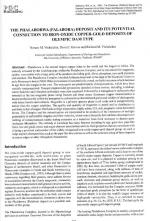Добрый день, Коллеги. Важное сообщение, просьба принять участие. Музей Ферсмана ищет помощь для реставрационных работ в помещении. Подробности по ссылке
The Phalaborwa (Palabora) deposit and its potential connections to iron-oxide copper-gold depositsof Olympic Dam type
Phalaborwa is the second largest copper mine in the world and the largest in Africa. The orebody is hosted by the Loolekop pipe within the Phalaborwa Complex, and is also mined for magnetite, apatite, vermiculite with a large array of by-products including gold, silver, phosphate, rare earth elements and uranium. The Phalaborwa Complex intruded Archaean basement at the edge of the Kaapvaal Craton in early Proterozoic times (2060±lMa) and consists of concentrically zoned, multiple intrusions which decrease in age from the margin to the core. The outer parts are predominantly clinopyroxenites, which have been variably metasomatised. Younger pegmatoidal pyroxenites intruded at three centres, including Loolekop, where foskcritc and a banded carbonatite were also emplaced, followed by a transgressive carbonatite that intruded as the last magmatic phase along fracture and shear zones. Economic copper mineralisation is hosted predominantly within the transgressive carbonatite as disseminated grains and veinlets of chalcopyrite, with lesser bornite and cubanite. Magnetite is a primary igneous phase in all rocks and is paragenetically earlier than the copper sulphides. The quality and quantity of magnetite is zoned and its distribution is antithetic to that of copper. Ore fluids are high temperature, highly saline, CO,-rich, magmatic-water dominated brines. The Complex and the mineralisation are interpreted to be products of the interaction of multiple pyroxenitic to carbonatitic magmas and their volatiles, which were ultimately derived from decompression melting of metasomatised mantle during extension at a transition from thick Archaean to thinner post-Archaean lithosphere. The orebody at Loolekop has many features including its age, giant size, pipe-like form, low ore grade, minor and major element associations and ore-fluid properties that are consistent with it being a proximal endmember of the widely recognised iron-oxide copper-gold deposit group. As such it helps explain characteristics such as the pipe-like brecciation as well as the common siting of these deposits at craton edges or other lithospheric boundaries.




